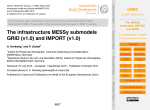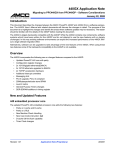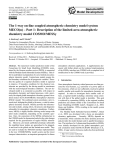Download Printer-friendly Version
Transcript
Geosci. Model Dev. Discuss., 3, C474–C476, 2010 www.geosci-model-dev-discuss.net/3/C474/2010/ © Author(s) 2010. This work is distributed under the Creative Commons Attribute 3.0 License. Geoscientific Model Development Discussions Interactive comment on “Development cycle 2 of the Modular Earth Submodel System (MESSy2)” by P. Jöckel et al. Anonymous Referee #1 Received and published: 26 October 2010 The authors present an updated version of the MESSy infrastructure designed for the development and application of comprehensive Earth System Models. MESSy version 2 is set up in a more general and flexible way to facilitate the coupling of submodels independently from the underlying basemodel. Beside some improvements of the existing chemistry setup, the new MESSy generation includes several new and useful infrastructure, diagnostic and process submodels. Overall, MESSy2 is an important contribution to the ESM community. I recommend this paper for publication after minor revisions as outlined below. General Comment: My major comment concerns the overall presentation and length of the manuscript. The paper is a mixture of technical description of new and modified submodels, user C474 manual and a rather short model evaluation that consists mainly of a large number of not commented figures in the supplement. I recommend to shorten the paper by moving the ’user manual’-like parts to a separate submodel documentation as it is already done for the submodels TIMER and CHANNEL. Furthermore, I suggest a revision of the evaluation section. In the current state this section is neither fish nor fowl. The authors might either extend the discussion or decide to publish a detailed model evaluation as a companion paper. Specific Comments: -Fig 1, 3, 5, 7, etc: I suggest to omit the example namelists of the new submodels and to provide a detailed submodel documentation including the example namelists as an additional supplement. -CHANNEL: For ECHAM5 users the CHANNEL submodel sounds like the streamelements used in ECHAM5. Maybe the authors can give some more information about differences and the changes necessary to make the data storage and management more generally applicable. -Has MESSy2 already been used with another GCM except ECHAM5? It would be very interesting to see how much effort is required to couple MESSy to another GCM. -Sect. 5.2, SCOUT.: Is it possible to select an individual output interval for the submodel SCOUT or is the output interval identical to the GCM output? -Sect. 7.1.1: In my opinion this section is dispensable and could be removed or at least substantially shortened. -Sect. 7.1.2: Is there any reference for equation 6? -Sect. 7.2: The submodel PSC and HETCHEM are obsolete, but remain available for compatibility with MESSy1. At the same the authors argument that maintaining different modules with the code is error-prone and not desirable. Does that mean that there will be no bug-fixes or updates for HETCHEM and PSC anymore? C475 -Sect. 7.3., LNOX: In the new version of LNOX the calculation of the flash frequency is based on a fractional instead of an integer land-sea-mask. Has this change any effect on the total amount or the distribution of NOx emissions from lightning? The decrease in flash frequency over Indonesia and Middle America is an improvement compared to MESSy1. How about the increase in flash frequency over South America and Africa? Is this also an improvement? Are the changes statistically significant? -Sect. 9: The description of the model configuration and set-up (9.1) is as long as the presentation of the model results (9.2). If the authors want to keep this section (see general comment), I suggest to extend the re-evaluation of the new model version. A few comments are given below. -Sect. 9: EMAC based on MESSy2 could be referred to as EMAC2. -Sect. 9.1.: How do the total biomass burning emissions differ between the current model simulation and the simulation S2 from Jöckel et al. (2006)? -Sect. 9.1.: Please give some information about the role of mercury in atmospheric chemistry. -Sect. 9.2.: I recommend to present the figures discussed in this section in the paper, not only in the supplement. -Sect. 9.2.: The discussion of the model results concerning mercury is rather sparse. Getting the best results by switching off certain oxidation reactions does not inspire much confidence. Please provide more details. -Fig. 11, right panel: This figure is not clear to me. The orbit position corresponding to the time of the model output is already shown in the left panel. -Supplement, evaluation of MESSy2, Fig 1-3: For a better comparison I suggest to add the respective figures from Jöckel et al. (2006). Interactive comment on Geosci. Model Dev. Discuss., 3, 1423, 2010. C476









